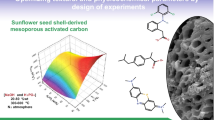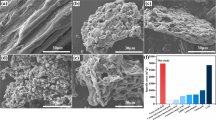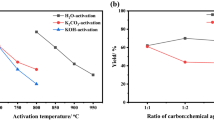Abstract
In the present study, a novel porous carbon obtained by K2CO3 activation of potato peel waste under optimized conditions was applied for the first time as liquid-phase adsorbent of sodium diclofenac in parallel with a commercial activated carbon. The biomass-activated carbon presented an apparent surface area of 866 m2 g−1 and well-developed microporous structure with a large amount of ultramicropores. The obtained carbon presented leaching and ecotoxicological properties compatible with its safe application to aqueous medium. Kinetic data of laboratory-made and commercial sample were best fitted by the pseudo-second-order model. The commercial carbon presented higher uptake of diclofenac, but the biomass carbon presented the higher adsorption rate which was associated with its higher hydrophilic nature which favoured external mass transfer. Both adsorbents presented adsorption isotherms that were best fitted by Langmuir model. The biomass carbon and the commercial carbon presented adsorption monolayer capacities of 69 and 146 mg g−1, and Langmuir constants of 0.38 and 1.02 L mg−1, respectively. The better performance of the commercial sample was related to its slightly higher micropore volume, but the most remarkable effect was the competition of water molecules in the biomass carbon.



Similar content being viewed by others
References
Aburto J, Moran M, Galano A, Torres-García E (2015) Non-isothermal pyrolysis of pectin: a thermochemical and kinetic approach. J Anal Appl Pyrolysis 112:94–104. doi:10.1016/j.jaap.2015.02.012
Ahokas M, Välimaa A, Lötjönen T, Kankaala A, Taskila S, Virtanen E (2014) Resource assessment for potato biorefinery: side stream potential in Northern Ostrobothnia. Agron Res 12(3):695–704
Arapoglou D, Varzakas T, Vlyssides A, Israilides C (2010) Ethanol production from potato peel waste (PPW). Waste Manag 30:1898–1920. doi:10.1016/j.wasman.2010.04.017
Baccar R, Sarrà M, Bouzid J, Feki M, Blánquez P (2012) Removal of pharmaceutical compounds by activated carbon prepared from agricultural by-product. Chem Eng J 211–212:310–317. doi:10.1016/j.cej.2012.09.099
Bozym M, Florczak I, Zdanowska P, Wojdalski J, Klimkiewicz M (2015) An analysis of metal concentrations in food wastes for biogas production. Renew Energ 77:467–472. doi:10.1016/j.renene.2014.11.010
Burkina V, Zlabek V, Zamaratskaia G (2015) Effects of pharmaceuticals present in aquatic environment on Phase I metabolism in fish. Environ Toxicol Pharmacol 40:430–444. doi:10.1016/j.etap.2015.07.016
Cabrita I, Ruiz B, Mestre A, Fonseca I, Carvalho A, Ania C (2010) Removal of an analgesic using activated carbons prepared from urban and industrial residues. Chem Eng J 163:249–255. doi:10.1016/j.cej.2010.07.058
Carabineiro S, Thavorn-Amornsri T, Pereira M, Serp P, Figueiredo J (2012) Comparison between activated carbon, carbon xerogel and carbon nanotubes for the adsorption of the antibiotic ciprofloxacin. Catal Today 186:29–34. doi:10.1016/j.cattod.2011.08.020
Delgado L, Charles P, Glucina K, Morlay C (2012) The removal of endocrine disrupting compounds, pharmaceutically activated compounds and cyanobacterial toxins during drinking water preparation using activated carbon—a review. Sci Total Environ 435–436:509–525. doi:10.1016/j.scitotenv.2012.07.046
El-Shafey E, Al-Lawati H, Al-Hussaini A (2014) Adsorption of fexofenadine and diphenhydramine on dehydrated and activated carbons from date palm leaflets. Chem Ecol 30(8):765–783. doi:10.1080/02757540.2014.894986
EU (2013) Directive 2013/39/EU of the European Parliament and of the Council of 12 August 2013 amending Directives 2000/60/EC and 2008/105/EC as regards priority substances in the field of water policy. Official Journal of the European Union, OJ L 226, 24.8.2013, pp 1–17
Evgenidou E, Konstantinou I, Lambropoulou D (2015) Occurrence and removal of transformation products of PPCPs and illicit drugs in wastewaters: a review. Sci Total Environ 505:905–926. doi:10.1016/j.scitotenv.2014.10.021
FAOSTAT (2015) Food and Agriculture Organization of the United Nations Statistics Division. http://faostat3.fao.org/home/E. Accessed December 2015
Fernandez M, Ledesma B, Román S, Bonelli P, Cukierman A (2015) Development and characterization of activated hydrochars from orange peels as potential adsorbents for emerging organic contaminants. Bioresour Technol 183:221–228. doi:10.1016/j.biortech.2015.02.035
Franz M, Arafat H, Pinto N (2000) Effect of chemical surface heterogeneity on the adsorption mechanism of dissolved aromatics on activated carbon. Carbon 38:1807–1819. doi:10.1016/S0008-6223(00)00012-9
Guinesi L, da Róz Corradini E, Mattoso L, Teixeira E, Curvelo A (2006) Kinetics of thermal degradation applied to starches from different botanical origins by non-isothermal procedures. Thermochim Acta 447:190–196. doi:10.1016/j.tca.2006.06.002
Gupta S, Bhattacharyya K (2011) Kinetics of adsorption of metal ions on inorganic materials: a review. Adv Colloid Interface Sci 162:39–58. doi:10.1016/j.cis.2010.12.004
Gurten I, Ozmak M, Yagmur E, Aktas Z (2012) Preparation and characterisation of activated carbon from waste tea using K2CO3. Biomass Bioenerg 37:73–81. doi:10.1016/j.biombioe.2011.12.030
Ho Y (2006) Review of second-order models for adsorption systems. J Hazard Mater 136:681–689. doi:10.1016/j.jhazmat.2005.12.043
Hoseinzadeh E, Samarghandi M, McKay G, Rahimi N, Jafari J (2013) Removal of acid dyes from aqueous solution using potato peel waste biomass: a kinetic and equilibrium study. Desal Water Treat 52(25–27):1–8. doi:10.1080/19443994.2013.810355
Huerta-Fontela M, Galceran M, Ventura F (2011) Occurrence and removal of pharmaceuticals and hormones through drinking water treatment. Water Res 45:1432–1442. doi:10.1016/j.watres.2010.10.036
Jodeh S, Abdelwahab F, Jaradat N, Warad I, Jodeh W (2015) Adsorption of diclofenac from aqueous solution using Cyclamen persicum tubers based activated carbon (CTAC). J Assoc Arab Univ Basic Appl Sci. doi:10.1016/j.jaubas.2014.11.002
Jung C, Park J, Lim K, Park S, Heo J, Her N, Oh J, Yun S, Yoon Y (2013) Adsorption of selected endocrine disrupting compounds and pharmaceuticals on activated biochars. J Hazard Mater 263:702–710. doi:10.1016/j.jhazmat.2013.10.033
Jung C, Boateng L, Flora J, Oh J, Braswell M, Son A, Yoon Y (2015) Competitive adsorption of selected non-steroidal anti-inflammatory drugs on activated biochars: experimental and molecular modeling study. Chem Eng J 264:1–9. doi:10.1016/j.cej.2014.11.076
Khawla B, Sameh M, Imen G, Donyes F, Dhouha G, Raoudha E, Oumèma N (2014) Potato peel as feedstock for bioethanol production: a comparison of acidic and enzymatic hydrolysis. Ind Crops Prod 52:144–149. doi:10.1016/j.indcrop.2013.10.025
Kincl M, Meleh M, Veber M, Vrečerd F (2004) Study of the physicochemical parameters affecting the release of diclofenac sodium from lipophilic matrix tablets. Acta Chim Sloven 51(3):409–425
Kyzas G, Deliyanni E (2015) Modified activated carbons from potato peels as green environmental-friendly adsorbents for the treatment of pharmaceutical effluents. Chem Eng Res Des 97:135–144. doi:10.1016/j.cherd.2014.08.020
Liang S, McDonald A (2012) Chemical and thermal characterization of potato peel waste and its fermentation residue as potential resources for biofuel and bioproducts production. J Agric Food Chem 62:8421–8429. doi:10.1021/jf5019406
Limousin G, Gaudet J-P, Charlet L, Szenknect S, Barthès V, Krimissa M (2007) Sorption isotherms: a review on physical bases, modelling and measurement. Appl Geochem 22:249–275. doi:10.1016/j.apgeochem.2006.09.010
Luo Y, Guo W, Ngo H, Nghiem L, Hai F, Zhang J, Liang S, Wang X (2014) A review on the occurrence of micropollutants in the aquatic environment and their fate and removal during wastewater treatment. Sci Total Environ 473–474:619–641. doi:10.1016/j.scitotenv.2013.12.065
Meloun M, Bordovská S, Galla L (2007) The thermodynamic dissociation constants of four non-steroidal anti-inflammatory drugs by the least-squares nonlinear regression of multiwavelength spectrophotometric pH-titration data. J Pharm Biomed Anal 45:552–564. doi:10.1016/j.jpba.2007.07.029
Mestre A, Pires J, Nogueira J, Carvalho A (2007) Activated carbons for the adsorption of ibuprofen. Carbon 45:1979–1988. doi:10.1016/j.carbon.2007.06.005
Mestre A, Pires R, Aroso I, Fernandes E, Pinto M, Reis R, Andrade M, Pires J, Silva S, Carvalho A (2014) Activated carbons prepared from industrial pre-treated cork: sustainable adsorbents for pharmaceutical compounds removal. Chem Eng J 253:408–417. doi:10.1016/j.cej.2014.05.051
Moreno-Castilla C (2004) Adsorption of organic molecules from aqueous solutions on carbon materials. Carbon 42:83–94. doi:10.1016/j.carbon.2003.09.022
Moreno-Piraján J, Giraldo L (2011) Activated carbon obtained by pyrolysis of potato peel for the removal of heavy metal copper (II) from aqueous solutions. J Anal Appl Pyrolysis 90:42–47. doi:10.1016/j.jaap.2010.10.004
Moreno-Piraján J, Giraldo L (2012) Immersion calorimetry applied to the study of the adsorption of phenolic derivatives onto activated carbon obtained by pyrolysis of potato peel. Mater Express 2:121–129. doi:10.1166/mex.2012.1057
Önal E, Uzun B, Pütün A (2011) Steam pyrolysis of an industrial waste for bio-oil production. Fuel Process Technol 92:879–885. doi:10.1016/j.fuproc.2010.12.006
Rivera-Utrilla J, Sánchez-Polo M, Ferro-García M, Prados-Joya G, Ocampo-Pérez R (2013) Pharmaceuticals as emerging contaminants and their removal from water. A review. Chemosphere 93:1268–1287. doi:10.1016/j.chemosphere.2013.07.059
Rodriguez-Reinoso F, Martin-Martinez J, Prado-Burguete C, McEnaney B (1987) A standard adsorption isotherm for the characterization of activated carbons. J Phys Chem 91:515–516. doi:10.1021/j100287a006
Rovani S, Censi M, Pedrotti S Jr, Lima É, Cataluña R, Fernandes A (2014) Development of a new adsorbent from agro-industrial waste and its potential use in endocrine disruptor compound removal. J Hazard Mater 271:311–320. doi:10.1016/j.jhazmat.2014.02.004
Ruiz B, Cabrita I, Mestre A, Parra J, Pires J, Carvalho A, Ania C (2010) Surface heterogeneity effects of activated carbons on the kinetics of paracetamol removal from aqueous solution. Appl Surf Sci 256:5171–5175. doi:10.1016/j.apsusc.2009.12.086
Saucier C, Adebayo M, Lima E, Cataluña R, Thue P, Prola L, Puchana-Rosero M, Machado F, Pavan F, Dotto G (2015) Microwave-assisted activated carbon from cocoa shell as adsorbent for removal of sodium diclofenac and nimesulide from aqueous effluents. J Hazard Mater 289:18–27. doi:10.1016/j.jhazmat.2015.02.026
Thommes M, Kaneko K, Neimark A, Oliver J, Rodriguez-Reinoso F, Rouquerol J, Sing K (2015) Physisorption of gases, with special reference to the evaluation of surface area and pore size distribution (IUPAC Technical Report). Pure Appl Chem 87:1051–1069. doi:10.1515/pac-2014-1117
Torrellas S, Lovera R, Escalona N, Sepúlveda C, Sotelo J, García J (2015) Chemical-activated carbons from peach stones for the adsorption of emerging contaminants in aqueous solutions. Chem Eng J 279:788–798. doi:10.1016/j.cej.2015.05.104
Vasquez M, Lambrianides A, Schneider M, Kümmerer K, Fatta-Kassinos D (2014) Environmental side effects of pharmaceutical cocktails: what we know and what we should know. J Hazard Mater 279:169–189. doi:10.1016/j.jhazmat.2014.06.069
Vieno N, Sillanpää M (2014) Fate of diclofenac in municipal wastewater treatment plant—a review. Environ Int 69:28–39. doi:10.1016/j.envint.2014.03.021
White P, Bradshaw J, Dale M, Ramsay G, Hammond J, Broadley M (2009) Relationships between yield and mineral concentrations in potato tubers. HortScience 44:6–11
Yahya M, Al-Qodah Z, Ngah C (2015) Agricultural bio-waste materials as potential sustainable precursors used for activated carbon production: a review. Renew Sustain Energ Rev 46:218–223. doi:10.1016/j.rser.2015.02.051
Yang H, Yan R, Chen H, Lee D, Zheng C (2007) Characteristics of hemicellulose, cellulose and lignin pyrolysis. Fuel 86:1781–1788. doi:10.1016/j.fuel.2006.12.013
Zekker I, Rikmann E, Tenno T, Saluste A, Tomingas M, Menert A, Loorits L, Lemmiksoo V, Tenno T (2012a) Achieving nitritation and anammox enrichment in a single moving-bed biofilm reactor treating reject water. Environ Technol 33:703–710. doi:10.1080/09593330.2011.588962
Zekker I, Kroon K, Rikmann E, Tenno T, Tomingas M, Vabamäe P, Vlaeminck S, Tenno T (2012b) Accelerating effect of hydroxylamine and hydrazine on nitrogen removal rate in moving bed biofilm reactor. Biodegradation 23:739–749. doi:10.1007/s10532-012-9549-6
Zekker I, Rikmann E, Tenno T, Lemmiksoo V, Menert A, Loorits L, Vabamäe P, Tomingas M, Tenno T (2012c) Anammox enrichment from reject water on blank biofilm carriers and carriers containing nitrifying biomass: operation of two moving bed biofilm reactors (MBBR). Biodegradation 23:547–560. doi:10.1007/s10532-011-9532-7
Zekker I, Rikmann E, Tenno T, Seiman A, Loorits L, Kroon K, Tomingas M, Vabamäe P, Tenno T (2014) Nitritating-anammox biomass tolerant to high dissolved oxygen concentration and C/N ratio in treatment of yeast factory wastewater. Environ Technol 35(12):1565–1576. doi:10.1080/09593330.2013.874492
Zekker I, Rikmann E, Tenno T, Kroon K, Seiman A, Loorits L, Fritze H, Tuomivirta T, Vabamäe P, Raudkivi M, Mandel A, Tenno T (2015) Start-up of low-temperature anammox in UASB from mesophilic yeast factory anaerobic tank inoculum. Environ Technol 36(2):214–225. doi:10.1080/09593330.2014.941946
Zekker I, Rikmann E, Mandel A, Kroon K, Seiman A, Mihkelson J, Tenno T, Tenno T (2016) Step-wise temperature decreasing cultivates a biofilm with high nitrogen removal rates at 9°C in short-term anammox biofilm tests. Environ Technol. doi:10.1080/09593330.2015.1135995
Zhang Y, Geißen S, Gal C (2008) Carbamazepine and diclofenac: removal in wastewater treatment plants and occurrence in water bodies. Chemosphere 73:1151–1161. doi:10.1016/j.chemosphere.2008.07.086
Acknowledgments
The authors would like to acknowledge the Portuguese Foundation for Science and Technology (FCT) for the financial support with the Post-Doc grants SFRH/BPD/93407/2013 and SFRH/BPD/84542/2012, respectively. The authors also thank FCT for the financial support to CQB and LAQV/REQUIMTE through the projects UID/MULTI/00612/2013 and UID/QUI/50006/2013, respectively. The authors thank Quimitejo for providing carbon CP.
Author information
Authors and Affiliations
Corresponding author
Electronic supplementary material
Below is the link to the electronic supplementary material.
Rights and permissions
About this article
Cite this article
Bernardo, M., Rodrigues, S., Lapa, N. et al. High efficacy on diclofenac removal by activated carbon produced from potato peel waste. Int. J. Environ. Sci. Technol. 13, 1989–2000 (2016). https://doi.org/10.1007/s13762-016-1030-3
Received:
Revised:
Accepted:
Published:
Issue Date:
DOI: https://doi.org/10.1007/s13762-016-1030-3




